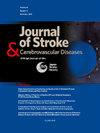Elevated initial blood kynurenine is associated with increased odds of post-stroke infection
IF 2
4区 医学
Q3 NEUROSCIENCES
Journal of Stroke & Cerebrovascular Diseases
Pub Date : 2025-02-25
DOI:10.1016/j.jstrokecerebrovasdis.2025.108268
引用次数: 0
Abstract
Objective
Post-stroke infection is a leading cause of acute ischemic stroke mortality. Tryptophan metabolites can modulate the immune response. This study assesses the association between tryptophan metabolism and post-stroke infection.
Methods
Whole blood from the University of Colorado Emergency Medicine Specimen Bank of acute ischemic stroke patients was collected within 72 hours of last known well. Mass spectrometry determined concentrations of tryptophan metabolites. Multivariate logistic regression modeled the association between post-stroke infection within 30 days and metabolite concentrations, controlling for age, sex, NIH stroke scale score, time to sample collection, smoking status, dysphagia, history of chronic kidney or end stage renal disease, and history of diabetes mellitus.
Results
Of 73 subjects, 21 (28.8 %) developed a post-stroke infection. Those with or without a post-stroke infection had similar concentrations of tryptophan, kynurenic acid and quinolinic acid. Those who developed a post-stroke infection had higher mean concentrations of kynurenine (2.3M, standard deviation 1.1M) compared to those who did not develop a post-stroke infection (1.6M , standard deviation 0.6M, p = 0.01). The adjusted odds ratio of a post-stroke infection within 30 days was 3.94 (95 % Confidence Interval 1.40 – 11.11) for every 1μM increase in kynurenine concentration.
Conclusions
Increasing circulating kynurenine within 72 hours of ischemic stroke onset is associated with increased odds of developing a post-stroke infection within 30 days of emergency department admission. Understanding the causal mechanism of kynurenine promoting post-stroke infection may yield targeted therapeutics that reduce the morbidity and mortality of ischemic stroke.
初始血犬尿氨酸升高与卒中后感染几率增加有关。
目的:脑卒中后感染是急性缺血性脑卒中死亡的主要原因。色氨酸代谢物可以调节免疫反应。本研究评估了色氨酸代谢与中风后感染之间的关系。方法:采集美国科罗拉多大学急诊医学标本库急性缺血性脑卒中患者术后72小时内的全血。质谱法测定色氨酸代谢物浓度。多因素logistic回归模拟了卒中后30天内感染与代谢物浓度之间的关系,控制了年龄、性别、NIH卒中量表评分、采样时间、吸烟状况、吞咽困难、慢性肾脏或终末期肾脏疾病史以及糖尿病史。结果:73例受试者中,21例(28.8%)发生脑卒中后感染。有或没有中风后感染的患者的色氨酸、犬尿酸和喹啉酸浓度相似。卒中后感染组犬尿氨酸平均浓度(2.3μM,标准差1.1μM)高于未发生卒中后感染组(1.6μM,标准差0.6μM, p=0.01)。犬尿氨酸浓度每升高1μM,卒中后30天内发生感染的校正优势比为3.94(95%可信区间1.40 ~ 11.11)。结论:缺血性卒中发作72小时内循环犬尿氨酸升高与急诊入院后30天内卒中后感染的发生率增加相关。了解犬尿氨酸促进脑卒中后感染的因果机制可能会产生降低缺血性脑卒中发病率和死亡率的靶向治疗方法。
本文章由计算机程序翻译,如有差异,请以英文原文为准。
求助全文
约1分钟内获得全文
求助全文
来源期刊

Journal of Stroke & Cerebrovascular Diseases
Medicine-Surgery
CiteScore
5.00
自引率
4.00%
发文量
583
审稿时长
62 days
期刊介绍:
The Journal of Stroke & Cerebrovascular Diseases publishes original papers on basic and clinical science related to the fields of stroke and cerebrovascular diseases. The Journal also features review articles, controversies, methods and technical notes, selected case reports and other original articles of special nature. Its editorial mission is to focus on prevention and repair of cerebrovascular disease. Clinical papers emphasize medical and surgical aspects of stroke, clinical trials and design, epidemiology, stroke care delivery systems and outcomes, imaging sciences and rehabilitation of stroke. The Journal will be of special interest to specialists involved in caring for patients with cerebrovascular disease, including neurologists, neurosurgeons and cardiologists.
 求助内容:
求助内容: 应助结果提醒方式:
应助结果提醒方式:


